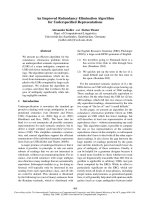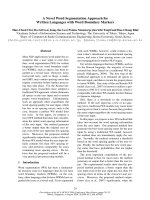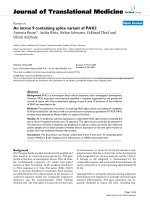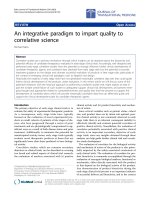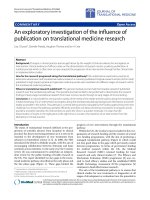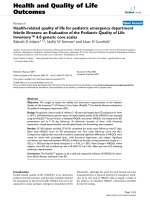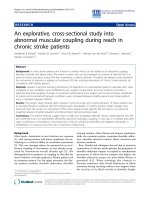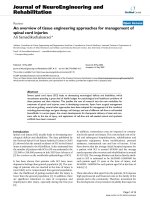Báo cáo hóa học: "An improved adaptive gain equalizer for noise reduction with low speech distortion" pptx
Bạn đang xem bản rút gọn của tài liệu. Xem và tải ngay bản đầy đủ của tài liệu tại đây (1.17 MB, 11 trang )
RESEARCH Open Access
An improved adaptive gain equalizer for noise
reduction with low speech distortion
Markus Borgh
1*
, Magnus Berggren
2
, Christian Schüldt
2
, Fredric Lindström
1
and Ingvar Claesson
2
Abstract
In high-quality conferencing systems, it is desired to perform noise reduction with as limited speech distortion as
possible. Previous work, based on time varying ampli fication controlled by signal-to-noise ratio estimation in
different frequency subbands, has shown promising results in this regard but can suffer from problems in
situations with intense continuous speech. Further, the amount of noise reduction cannot exceed a certain level in
order to avoid artifacts. This paper establishes the problems and proposes several improvements. The improved
algorithm is evaluated with several different noise characteristics, and the results show that the algorithm provides
even less speech dis tortion, better performance in a multi-speake r environment and improved noise suppression
when speech is absent compared with previous work.
Keywords: speech enhancement, noise reduction, noise-level estimation
1 Introduction
When communicating using hands free devices such as
speakerphones, the speech signal is typically corrupted by
background noise such as ventilation noise or computer
fan noise. One commonly used method for reducing this
type of noise is spectral subtraction [1,2]. Although typi-
cally achieving well in terms of noise reduction, the basic
spectral subtraction algorithm has often the effect that
musical noise a ppears due to spectral flooring [3]. Ways
of reducing the musical noise has been proposed b y e.g.
Ephraim and Malah [4], although this method still tends
to give audible artifacts which could in some cases even
result in reduced listening comfort compared to the ori-
ginal unproces sed signal [5]. Furt her improvements have
been made by Plapous et al. [6] in which they introduce a
two-step noise reduction technique that reduces the
noise without adding artifacts to the speech signal. How-
ever, this algorithm aims at reducing speech harmonics
distortion and does nothing for the unvoiced speech.
A time domain speech enhancement (“booster”)algo-
rithm, in this paper denoted the speech booster algorithm
(SBA), has been proposed by Westerlund et al. [7] in
which the audio signal is amplified according to a signal-
to-noise ratio (SNR) estimate in subbands. The gain is
calculated for a subband divided signal, and the gains in
each subband are independent of each other. Advantages
of SBA are the low computational complexity compared
to other algorithms with similar amount of speech
enhancement [8] as well as the ease of implementation
and the absence of musical noise if the gains are con-
trolled with care [7].
However, SBA suffers from a massive drawback which
manifests itself in situations with intense continuous
speech. In this type of situations, the subband SNR esti-
mates will gradually become inaccurate, resulting in
undesired damping and ultimate ly reduced speech signal
quality.
This paper demonstrates the dr awback and proposes a
modification to avoid this drawback. Further, the paper
presents additional improvements in the form of a gain
modified to produce less speech distortion and to provide
more noise damping in speech pauses.
The outline of the paper is as follows. In Sectio n 2, the
original SBA presented in [7] is described, and in Section
3, the proposed improvements are presented. Section 4
describes the simulation setup used for comparing the ori-
ginal SBA to the proposed method and Section 5 presents
the results. Section 6 compares the SBA and the proposed
method using objective speech distortion and SNR
increase measures during speech. A short comment on
* Correspondence: markus.borgh@lime saudio.com
1
Limes Audio AB, Box 7961, 90719 Umeå, Sweden
Full list of author information is available at the end of the article
Borgh et al. EURASIP Journal on Audio, Speech, and Music Processing 2011, 2011:7
/>© 2011 Borgh et al; licensee Springer. This is an Open Access article distributed under the terms of the Creative Commons Attribution
License ( g/licenses/by/2.0), which permits unrestricted use, distribution, and reproduction in any medium,
provided the original work is properly cited.
subjective evaluation is presented in Section 7, followed by
the conclusions in Section 8.
2 The speech booster algorithm
The noisy speech is denoted x(n), where n is the sample
index, and is assumed to consist of the desired speech
signal s(n) and additive noise v(n)
x
(
n
)
= s
(
n
)
+ v
(
n
).
(1)
A filterbank consisting of K bandpass filters is used to
divide the input signal x(n) into K subband signals, each
denoted x
k
(n)wherek Î [0, K - 1]. The output signal is
then formed by weighting and summation of the sub-
band signals according to
y(n)=
K
−1
k
=
0
g
1,k
(n)x
k
(n)
,
(2)
where g
1,k
(n) is the subband gain based on estimation
of the SNR in subband k. Calculation of the subband
gain is performed as
g
1,k
(n)=min
A
k
(n)
B
k
(
n
)
p
k
, L
k
,
(3)
where A
k
(n) is an estimate of the noisy speech sig nal
level, B
k
(n)isanestimateofthenoiselevel,L
k
is a
threshold determining the maximum allowed gain in
subband k and p
k
≥ 0 is a constant denoted the gain rise
exponent [7].
The noisy speech level is estimated by taking a short-
time average of the input signal according to
A
k
(
n
)
= α
k
A
k
(
n − 1
)
+
(
1 − α
k
)
|x
k
(
n
)
|
,
(4)
where 0 ≤ a
k
≤ 1 is a forgetting factor constant.
Estimation of the n oise level is based on the short-
time average A
k
(n)as
B
k
(n)=
A
k
(n)ifA
k
(n) ≤ B
k
(n − 1)
,
(1 + β
k
)B
k
(n − 1) otherwise,
(5)
where b
k
is a positive constant defining the increase
rate of the noise level.
3 The proposed method
One problem with the SBA as described in the previous
section is the noise-level estimation in (5). During
intense continuous speech, the noise-level estimate B
k
(n) will increase and cause reduction of the speech
boosting gain, see (3).
To overcome this problem, an alternative noise esti-
mation method is proposed. The proposed noise estima-
tor utilizes a modified update scheme according to
B
k
(n)=
⎧
⎪
⎪
⎨
⎪
⎪
⎩
A
k
(n)ifA
k
(n) ≤ B
k
(n − 1),
B
k
(n − 1) if A
k
(n) > B
k
(n − 1)
,
and φ(n)=1
(1 + β
k
)B
k
(n − 1) otherwise,
(6)
where j(n) is an update controller, which can take on
the values 1 (no update) or 0 (update). Use of the noise
estimation update controller j (n) prevents noise estima-
tion during speech and thus eliminates the problem of
speech boosting gain reduction during intense continu-
ous speech.
The noise estimation update controller is defined as
φ(n)=
1ifS
k
(n) ≥ T
φ,k
for any
k
0otherwise
(7)
where T
j,k
is a t hreshold and S
k
(n)istheratio
between the maximum and minimum signal magnitudes
in accumulated blocks defined as
S
k
(n)=
max
q∈{0, ,N
b
−1}
F
k
(l − q)
δ + min
q
∈{0, ,N
b
−1}
F
k
(l − q)
.
(8)
In (8), N
b
is the number of blocks, used for the esti-
mation of S
k
(n), 0 <δ ≪ 1 is a constant included for
avoiding division by zero, and F
k
(l) is the accumulated
signal block
F
k
(l)=
N
s
−1
i
=
0
x
k
(lN
s
− i)
,
(9)
where N
s
is the number of samples accumulated i n
every block. The block index l Î ℤ fulfills
lN
s
≡ n
.
(10)
The essence of (8) is to compare the largest accumulated
signal block (numerator) with the smallest block (denomi-
nator), out of the N
b
most recent (in time) blocks. A high
ratio S
k
(n) indicates that the signal x
k
(n ) currently could
be regarded as non-stationary under the considered time-
frame, meaning in this context that the current signal con-
tent is likely to be dominated by speech. A low ratio S
k
(n)
on the other hand means that the signal x
k
(n) is likely to
be dominated by stationary (still under the considered
time-frame) noise. The noise estimation update controller
(7) then allows noise estimation once S
k
(n)isbelowthe
threshold T
j,k
for all k.
A second problem with the original SBA is that if L
k
is
set too high, there is a risk of fast pumping of the noise
and distortion of the speech [7]. To avoid this while still
providing significant reduction of the noise in speech
pauses, a second gain factor is proposed. This gain factor
denoted the fullb and gain, g
2
(n ), only provides damping,
Borgh et al. EURASIP Journal on Audio, Speech, and Music Processing 2011, 2011:7
/>Page 2 of 11
i.e. reduces the noise, in longer speech pause s and is
applied to the input signal as
y(n)=g
2
(n)
K−1
k
=
0
g
1,k
(n)x
k
(n)
.
(11)
The proposed fullband gain is based on a gain con-
troller
0
(n), which is defined as
ϕ
0
(n)=
⎧
⎨
⎩
1if
1
K
K
k=1
g
1,k
(n) ≥ T
ϕ
0otherwise
(12)
where T
is a threshold. Further, to avoid changes in
g
2
(n) during short speech pauses a hold function of n
h
samples is introduced for the gain contr oller (n) which
then becomes
ϕ(n)= max
q
∈{0, ,n
h
−1}
ϕ
0
(n − q)
.
(13)
The fullband gain is expressed as
g
2
(
n
)
= λ
(
n
)
g
2
(
n − 1
)
+
(
1 − λ
(
n
))
L
(
n
)
(14)
where l(n) is the forgetting factor and L(n)isthetar-
get damping value. The speech pause-driven gain g
2
(n)
is designed to quickly adapt to a certain value L
f
with
smoothing parameter l
f
and adapt slowly to the level L
s
<L
f
with a smoothing parameter l
s
>l
f
.Theshift
between these regions is decided with
L(n)=
⎧
⎪
⎪
⎨
⎪
⎪
⎩
1ifϕ(n)=1
L
f
if ϕ(n)=0
and g
2
(n − 1) > L
f
(1 +
)
L
s
otherwise
(15)
and
λ(n)=
⎧
⎪
⎪
⎨
⎪
⎪
⎩
0ifϕ(n)=1
λ
f
if ϕ(n)=0
and g
2
(n − 1) > L
f
(1 +
)
λ
s
otherwise
(16)
where Δ is a sm all positive constant defining the limit
of transition between the regions of fast and slow
damping.
As can be seen in (12), the proposed fullband gain
directly depends on the subband gains g
1,k
; if sufficient
gain is applied in the subbands (during speech), the gain
controller (n) will be 1, indicating that the fullband gain
should rise, see (15) and (14). On the other hand, if little
subband gain is applied (when only stationary noise is pre-
sent), the gain controller (n) will be 0, indicating that the
fullband gain should fall, see (16) and (14).
The fullband gain g
2
(n) could be said to consist of
three regions. The first region, L(n) = 1, is used when
speech is present. The secon d region, L(n)=L
f
,isused
directly after a speech segment in the audio signal. In
this region, the gain is quickly reduced, which reduces
the noise that is no longer masked by the speech. Since
the adaption to the lowest gain in this region is rela-
tively fast, the amount of noise suppression cannot be
toolargesincethatwouldgiveanon-comfortable
sounding alteratio n of the noise level. Instead, the third
region, L(n)=L
s
, i s used to adapt to the lowest desired
gain. This adaption is fairly slow in order to make the
transition between the noise levels less apparent.
Further, instead of the full-rate filterbank structure
used in [7], it is proposed to use a polyphase filterbank
with downsampling [9] to provide reduction in compu-
tational complexity. In this paper, a decimation rate of
32 was used. For detailed information about polyphase
filterbanks, the reader is referred to [9,10] and the refer-
ences therein.
4 Simulation setup
To compare the performance of the SBA and the pro-
posed algorithm, several simulations were conducted.
The audio signals used in the evaluation were speech
signals consisting of recorded speech and a noise signal
consist ing of recorded ventilation noise. All signals were
sampled with 16-kHz sampling frequency. Evaluation
was performed with different SNRs, which was achieved
by varying the noise level thro ugh multiplication with a
noise gain factor h
v
as
v
(
n
)
= η
v
w
(
n
)
(17)
where w(n) is the ventilation noise signal. The signal w
(n) is shown in Figure 1 along with both versions of
speech signal s(n).
4.1 Common parameter setup
In this section, the setup of the parameters used by both
the SBA and the proposed algorithm is discussed. It
should be noted that the same parameter settings were
used for both algorithms when possible in the
simulations.
To avoid artifacts such as musical noise, the difference
in gain between two separate subbands cannot be too
large. On the other hand, the larger the allowed differ-
ence–the more noise reduction is achieved. A suitable
choice of maximum subband gain is in the region 10 ≤ |
20 log
10
L
k
| ≤ 25 dB [7].
The forgetting factor a
k
is chosen so that the gain g
1,k
(n) will be stable and less affected by impulsive noises
compared to a lower setting of a
k
.Westerlundetal.
recommend a lower setting of a
k
but also mention that
tweaking this parameter could lead to improved perfor-
mance depending on the noise environment.
Borgh et al. EURASIP Journal on Audio, Speech, and Music Processing 2011, 2011:7
/>Page 3 of 11
Further, the relationship between the SNR estimate
A
k
(n)
B
k
(
n
)
and the subband gain g
1,k
(n) is decided by the gain
rise exponent p
k
, see (3). If a linear relationship is desired,
then p
k
=1andifp
k
> 1, an alteration of the SNR esti-
mate will have a larger effect on the gain than if p
k
<1.
For the simulations, a setting of p
k
= 1 was chosen.
4.2 Parameter setup for the proposed algorithm
The proposed algor ithm contains a number of addi-
tional parameters that should be tuned. In this section,
the setup of the additional parameters is discussed.
As described in Section 3, the proposed algorithm
incorporates a fullband gain g
2
(n), which has the
purpose of damping noise in longer speech pauses. The
gain limi tati on L
f
describes the first damping limit of g
2
(n). If this is too large, there is a risk of rapid noise
pumping. The last gain limitation parameter L
s
should
be set according to the desired maximum total noise
damping |20 log
10
(L
k
L
s
)| dB.
The setup of the gain controller (n)wasdoneby
adjusting the parameters T
and n
h
. The hold time para-
meter n
h
is to be altered depending on how fast the
additional noise damping g
2
(n) should start to affect the
signal. A short hold time would imply noticeable addi-
tional noise reduction in short speech pauses but could
on the other hand cause annoying pumping of the noise
0 2 4 6 8 10 12 14 16 18 20
−1
−0.5
0
0.5
1
Time [s]
s(n)
(a)
0 2 4 6 8 10 12 14 16 18 20
−1
0
1
Time [s]
s(n)
(b)
0 2 4 6 8 10 12 14 16 18 20
−1
0
1
Time [s]
w(n)
(c)
Figure 1 In a and b, different speech signals s(n) and in c the noise signal w(n) used in the simulations are shown.
Borgh et al. EURASIP Journal on Audio, Speech, and Music Processing 2011, 2011:7
/>Page 4 of 11
level. A longer hold time lessens this noise level pump-
ing effect, but would not cause any noticeable additional
noise damping in short speech pauses. Further, the
threshold T
should be set with the maximum allowed
subband noise damping L
k
in mind. The threshold
should be T
>L
k
for the controller to be able to deacti-
vate. A recommended threshold setting is T
≈ 2L
k
.For
the simulations in this paper, the setting T
=0.5was
used.
The setup of the noise estimation update controller j
(n) was done by adjusting the parameters T
j,k
, N
b
and
N
s
. The controller makes a decision based on the pre-
vious N
b
N
s
samples, which implies that by adjusting
these parameters, the behavior of j(n) is greatly affected.
The threshold T
j,k
marks the decision point for distin-
guishing between speech and noise. If |20 log
10
T
j,k
|=
10, the ratio between the largest and smallest signal
block has to be at least 10 dB for the noise estimation
to halt. This is the setting used in the simulations.
Moreover, t he smoothing parameter b
k
was adjusted so
that the adaption to an increased noise level would be
approximately 2 dB/s for both the SBA and the pro-
posed algorithm. This corresponds to b
k
= 2.8 × 10
-4
for
the SBA and b
k
= 6.3 × 10
-4
for the proposed algorithm.
5 Behavior of the algorithm
In this section, the two main advantages of the proposed
algorithm o ver the original SBA are demonstrated. The
parameter values used are listed in Table 1.
5.1 Estimation of the noise level
In Figure 2, the subband gain g
1,k
(n) in one subband (k =
1) (plot a) and the corresponding level estimates A
k
(n)and
B
k
(n) (plot b) are shown for an input signal containing
both noise (h
v
=1,SNR≈ 3dB) and continuous speech.
The speech signal consists of multiple speakers overlap-
ping, a situation which frequently occurs in a normal dis-
cussion with a large number of participants. The noise
estimation approach in the SBA and the proposed method
are compared. For the SBA, the noise-level estimate gradu-
ally rises during the speech segments of the audio signals.
This causes the subband gain g
1,k
(n ),showninFigure2
plot a (dashed), to decrease during longer speech segments
since the SNR estimate will be lower than the actual SNR.
It is clea r that the original SBA suffer s from problems in
this case, whereas the proposed solution does not. For the
proposed solution, displayed in Figure 2 plot b (dotted),
the update controller j(n) activates during the speech seg-
ment of the displayed signal. This produces a stable noise-
level estimate during the speech segment and thus a more
correct subband gain is applied. It should be noted that the
difference in subband gain between the proposed solution
and the SBA is sometimes as large as 10 dB, which is a
highly audible difference.
In Figure 3, the subband gain g
1,k
( n)inonesubband
(k = 1) and the corresponding level estimates A
k
(n)and
B
k
(n) are shown for an input signal containing only noise
(h
v
= 1), with a sudden noise level increase (h
v
=3)after
20 s. It can be seen that the performance of the proposed
algorithm is similar to that of the original SBA.
Thus, by using an update controller, the noise-level
estimation performance is improved. With a suitable
choice of T
j,k
, the noise estimation update controller j
( n) becomes active during speech segments while still
being able to adapt to changing noise levels. Wit hout
the proposed update c ontroller, i.e. the SBA, the noise-
level estimation will over time rise to a higher level than
the actual background noise level. The only way of
reducing this effect would b e to decrease the value of
b
k
, but this would in turn also result in slower adapti on
to an increased noise level.
Further, one important property of the update controller
j(n) is that it should never fail to activate when speech is
present. In this case, it is better to halt the update too
often than too seldom. A faulty update causes the esti-
mated noise level to increase duri ng speech which in the
long term could cause a noise-level estimation B
k
(n)as
high as the actual speech level A
k
( n), as discussed pre-
viously and shown in Figure 3 for the SBA.
5.2 Noise damping in longer speech pauses
In Figure 4, the effect of the proposed algorithm on a
noisy speech signal (Figure 1 plot b and h
v
=1,SNR≈
4 dB) is shown for the SBA and the proposed algorithm.
The total subband gain G
k
( n), defin ed as G
k
( n)=g
1,k
( n)intheSBAcaseandG
k
( n)=g
1,k
( n) g
2
( n)forthe
proposed algorithm, is plotted along with the resulting
output signals in a specific subband (k = 1). From Figure
4 plot a, it can be seen that for the proposed algorithm,
the noise is reduced with as much as 27 dB after 26 s.
Thus, the inclusion of the proposed additional gain g
2
(n) leads to a reduced noise level during speech pauses,
Table 1 Parameter values used in simulations
Parameter Value
L
k
, ∀k 0.25
L
f
0.5
L
s
0.125
Δ 0.05
a
k
, ∀k 0.984
l
f
0.9687
l
s
0.999
p
k
, ∀k 1
N
b
64
N
s
8
n
h
100
δ 2.2 × 10
-16
Borgh et al. EURASIP Journal on Audio, Speech, and Music Processing 2011, 2011:7
/>Page 5 of 11
without affecting the quality of the speech. The addi-
tional gain will cause no speech distortion as the gain is
constant (with value g
2
(n ) = 1) during speech. Further,
it does not change the spectral characteristics of the
noise since all subbands are equally attenuated and the
damping is changing slowly. T he damping level L
s
can
20 25 30 35 40
−15
−10
−5
0
Time [s]
g
1,1
(n) [dB]
(a)
SBA
Proposed
20 25 30 35 40
−80
−75
−70
−65
−60
Time [s]
Averages [dB]
(b)
A
1
(n)
B
1
(n) : SBA
B
1
(n) : Proposed
20 25 30 35 40
−1
−0.5
0
0.5
1
Time [s]
x(n)
(c)
Figure 2 In plot a, the subband gains g
1,k
(n) for the SBA and the proposed solution is shown. In plot b, the noisy speech level estimate
A
k
(n)(solid) and the noise-level estimates B
k
(n)(dotted), corresponding to the subband gains in plot a, are shown. The signal averages A
k
(n) and
B
k
(n) are calculated for a signal consisting of speech and noise in subband k = 1. In plot c, a time domain plot of the input signal x(n) is shown.
Borgh et al. EURASIP Journal on Audio, Speech, and Music Processing 2011, 2011:7
/>Page 6 of 11
15 20 25
−15
−10
−5
0
Time [s]
g
1,1
(n) [dB]
(a)
SBA
Proposed
15 20 25
−80
−75
−70
−65
Time [s]
Averages [dB]
(b)
A
1
(n)
B
1
(n) : SBA
B
1
(n) : Proposed
15 20 25
−1
−0.5
0
0.5
1
Time [s]
x(n)
(c)
Figure 3 In plot a, the subband gains g
1,k
(n) for the SBA and the proposed solution is shown. In plot b, the noisy speech level estimate
A
k
(n)(solid) and the noise-level estimates B
k
(n)(dotted), corresponding to the subband gains in plot a, are shown. The signal averages A
k
(n) and
B
k
(n) are calculated for a signal consisting of only noise in subband k = 1. A sudden increase in the actual noise level takes place after 20 s. In
plot c, a time domain plot of the input signal x(n) is shown.
Borgh et al. EURASIP Journal on Audio, Speech, and Music Processing 2011, 2011:7
/>Page 7 of 11
even be set so that the noise becomes completely inaud-
ible when maximum damping is applied.
6 Objective signal quality comparisons
To evaluate the performance of the SBA and the pro-
posed algorithm in terms of speech quality and noise
reduction, the SNR gain and speech distortion index
[11,12] were used. The SNR gain, gSNR, is the differ-
ence between the input and output SNR, according to
g
SNR = oSNR −
i
SNR
.
(18)
In (18), i SNR and oSNR denote the input- and output
SNR, respectively, defined as
iSNR = 10 log
10
E{s
2
(n)}
E{v
2
(
n
)
}
,
(19)
and
oSNR = 10log
10
E{
˜
s
2
(n)}
E{
˜
v
2
(
n
)
}
,
(20)
14 16 18 20 22 24 26 28
−30
−20
−10
0
Time [s]
(a)
G
1
(n) [dB]
14 16 18 20 22 24 26 28
Time [s]
(b)
Re{y
1
(n)}
14 16 18 20 22 24 26 28
Time [s]
(c)
Re{y
1
(n)}
T
ϕ
=Proposed
T
ϕ
=SBA
Figure 4 In plot a, the total gain G
k
(n) in subband k = 1 for the SBA and the proposed algorit hm is shown.Inplotb, the processed
audio signal y
k
(n) in the same subband is shown for the SBA. In plot c, the processed audio signal y
k
(n) in the same subband is shown for the
proposed algorithm.
Borgh et al. EURASIP Journal on Audio, Speech, and Music Processing 2011, 2011:7
/>Page 8 of 11
where
˜
s(n)=g
2
(n)
K−1
k
=
0
g
1,k
(n)s
k
(n)
,
(21)
and
˜
v(n)=g
2
(n)
K−1
k
=
0
g
1,k
(n)v
k
(n)
,
(22)
where sk(n) and vk(n) are the subband versions of s(n)
and v(n), respectively, and
E
{
·
}
denotes expected value.
The speech distortion index ν
sd
is a measure of how
much the speech signal has been altered [11] and
defined as
ν
sd
=10log
10
⎛
⎝
E
(
˜
s(n) − s(n))
2
E{s
2
(n)}
⎞
⎠
.
(23)
Both the speech distortion index and the SNR gain are
calculated globally. It should be noted that the SNR gain
and the speech distortion index are only evaluated when
there is an active speech signal. Noise-only parts of the
signal are not included in this part of the evaluation.
The objective comparison was performed with four
different noise sources; noise recorded in a moving car
traveling with a speed of 100 km/h, computer fan noise,
ventilation noise and babble noise consisting of approxi-
mately 10 simultaneous speakers. Five different input
SNR levels were used: 0, 6, 12, 18, and 24 dB. The
increase rate of the noise-level estimation was set to 1
dB/s (b
k
=2.3×10
-4
), 3 dB/s (b
k
=6.9×10
-4
), 6 dB/s
(b
k
=1.4×10
-3
), and 9 dB/s (b
k
=2.1×10
-3
)forboth
the SBA and the proposed method. T he speech signals
used in the evaluation were from the English speaking
test samples of the ITU-T recommendation P.501 [13]
and consisted of four speakers (2 male and 2 female)
pronouncing one sentence each.
Figure 5 shows the speech distortion index for the
SBA and the proposed algorithm. It can be seen that the
speech distortion decreases with an increasing input
SNR for both the SBA and the proposed method, which
0 5 10 15 20 25
−40
−30
−20
−10
0
iSNR [dB]
ν
sd
[dB]
(a)
1 dB/s
3 dB/s
6 dB/s
9 dB/s
0 5 10 15 20 25
−40
−30
−20
−10
0
iSNR [dB]
ν
sd
[dB]
(b)
1 dB/s
3 dB/s
6 dB/s
9 dB/s
0 5 10 15 20 25
−40
−30
−20
−10
0
iSNR [dB]
ν
sd
[dB]
(c)
1 dB/s
3 dB/s
6 dB/s
9 dB/s
0 5 10 15 20 25
−40
−30
−20
−10
0
iSNR [dB]
ν
sd
[dB]
(d)
1 dB/s
3 dB/s
6 dB/s
9 dB/s
Figure 5 Speech distortion index for different noise characteristic s and input SNR for both SBA (dashdot) and proposed (solid).
Different increase rates, b
k
, to a higher noise level (1, 3, 6, and 9 dB/s) were used. In a, the noise consists of noise recorded in a moving car, in
b the noise comes from a computer fan, in c the noise comes from a ventilation system and in d the noise is babble noise from approximately
10 speakers.
Borgh et al. EURASIP Journal on Audio, Speech, and Music Processing 2011, 2011:7
/>Page 9 of 11
is expected since the fluctuations of the subband gains
decrease as the input SNR increases. It can also be seen
that the speech distortion of the proposed method is
consistently lower than the SBA for all used noise
sources and input SNRs.
For rapid increase rates of the noise-level estimation
(i.e. large b
k
), the SBA distorts the speech more than for
a slower increase rate. This is due to the adaption of the
noise-level estimation during speech, as demo nstrated in
Section 5.1. The proposed meth od does not have this
increase in speech distortion for higher noise-level esti-
mation increase rates. Thus, the proposed method
allows much more rapid noise-level adaptation without
any significant increase in speech distortion, compared
to the orig inal SBA. T his behavior i s consistent for all
used noise sources, even for the non-stationary babble
noise.
Figure 6 shows the SNR gain during active speech
for both methods. From this figure, it can be seen that
the SBA shows slightly higher SNR gain than the pro-
posed method. This demonstrates the well-known
trade-off between speech distortion and SNR improve-
ment [11].
Of particular interest are the results of the babble
noise, see Figures 5d and 6d. In this case, neither the
SBA nor the proposed algorithm achieve any significant
SNR improvement (less than 2 dB), due to the highly
non-stationary nature of the noise. However, the speech
distortion is significantly less for the proposed algorithm
owing to the improved noise estimation.
0 5 10 15 20 25
0
2
4
6
8
10
iSNR [dB]
gSNR [dB]
(a)
1 dB/s
3 dB/s
6 dB/s
9 dB/s
0 5 10 15 20 25
0
2
4
6
8
10
iSNR [dB]
gSNR [dB]
(b)
1 dB/s
3 dB/s
6 dB/s
9 dB/s
0 5 10 15 20 25
0
2
4
6
8
10
iSNR [dB]
gSNR [dB]
(c)
1 dB/s
3 dB/s
6 dB/s
9 dB/s
0 5 10 15 20 25
0
2
4
6
8
10
iSNR [dB]
gSNR [dB]
(d)
1 dB/s
3 dB/s
6 dB/s
9 dB/s
Figure 6 SNR gain during active speech for different noise signals and input SNR for both SBA (dashdot) and proposed (solid).
Different increase rates, b
k
, to a higher noise level (1, 3, 6, and 9 dB/s) were used. In a, the noise consists of noise recorded in a moving car, in
b the noise comes from a computer fan, in c the noise comes from a ventilation system and in d the noise is babble noise from approximately
10 speakers.
Borgh et al. EURASIP Journal on Audio, Speech, and Music Processing 2011, 2011:7
/>Page 10 of 11
7 Comments on subjective evaluation
The algorithm behavior presented in Section 6 only
describes the performance in active speech regions. The
contribution of the additional noise reduction, g
2
(n),
applied durin g speech pau ses cannot be discerned fro m
these results. However, this additional gain will reduce
the noise level even further resulting in a much lower
noise level compared to the SBA. In a conference phone
application, a typical scenario is that parts on one side
“listen in” to an ongoing presentation conducted by talk-
ers on the opposite side. The extra noise reduction by g
2
(n) in speech pauses reduces annoyance from continu-
ous noise in these situati ons. The mo dificat ions in this
paper were motivated by artifacts from the SBA algo-
rithm, subjectively perceived by an evaluation panel of
product managers and development engineers, in total 6
persons. The improvements proposed in this paper were
considered as necessary improvements to the SBA, and
the proposed algorithm was implemented in a commer-
cially available product. Especially, the inclusion of the
additional gain g
2
(n) in (11) was perceived as desirable.
8 Conclusions
The noise reduction algorithm presented in this paper is
an improvement in the SBA approach presented in [7],
which incorporates subband division of the audi o sign al
with a noise damping in each subband. The s ubband
damping is proportional to the current SNR estimate in
the corresponding subband, yielding noise reduction
with low levels of speech distortion. The proposed algo-
rithm introduces an additional noise reduction function-
ality, which is applied in speech pauses, allowing the
noise level to be further reduced without adding any
speech distortion.
Moreover, the proposed algorithm introduces a noise
estimation update controller and a gain controller is
used to determine whether the audio signal contains
speech or only background noise. Owing to this fact, it
is possible to obtain a more reliable noise level estima-
tion and thus the gain in each subband will correspond
to the actual S NR, resulting in less speech distortion
compared to the original SBA.
Comparisons between the SBA and the proposed algo-
rithm in four different noise conditions, including non-
stationary babble noise, show that the proposed method
introduces less (in some cases up to 25 dB less) speech
distortion for all evaluated input SNRs.
9 Competing int erests
The authors declare that they have no c ompeting
interests.
Author details
1
Limes Audio AB, Box 7961, 90719 Umeå, Sweden
2
Department of Electrical
Engineering, Blekinge Institute of Technology , 37179 Karlskrona, Sweden
Received: 14 February 2011 Accepted: 26 October 2011
Published: 26 October 2011
References
1. SF Boll, Suppression of acoustic noise in speech using spectral subtraction.
IEEE Trans Acoust Speech Signal Process. 27, 113–120 (1979). doi:10.1109/
TASSP.1979.1163209
2. PC Loizou, Speech Enhancement: Theory and Practice (CRC Press, Taylor &
Francis Group, 2007)
3. Z Goh, K-C Tan, BTG Tan, Postprocessing method for suppressing musical
noise generated by spectral subtraction. IEEE Trans Speech Audio Process.
6, 287–292 (1998). doi:10.1109/89.668822
4. Y Ephraim, D Malah, Speech enhancement using a minimum mean-square
error short-time spectral amplitude estimator. IEEE Trans Acoust Speech
Signal Process. 32, 1109–1121 (1984). doi:10.1109/TASSP.1984.1164453
5. Y Uemura, Y Takahashi, H Saruwatari, K Shikano, K Kondo, Musical noise
generation analysis for noise reduction methods based on spectral
subtraction and MMSE STSA estimation, in ICASSP ‘09: Proceedings of the
2009 IEEE International Conference on Acoustics, Speech and Signal Processing,
4433–4436 (2009)
6. C Plapous, C Marro, P Scalart, Improved signal-to-noise ratio estimation for
speech enhancement. IEEE Trans Acoust Speech Signal Process. 14,
2098–2108 (2006)
7. N Westerlund, M Dahl, I Claesson, Speech enhancement for personal
communication using an adaptive gain equalizer. Signal process. 85,
1089–1101 (2005). doi:10.1016/j.sigpro.2005.01.004
8. R Flynn, E Jones, Combined speech enhancement and auditory modelling
for robust distributed speech recognition. Speech Commun. 50, 797–809
(2008). doi:10.1016/j.specom.2008.05.004
9. E Hänsler, G Schmidt, Acoustic Echo and Noise Control: A Practical Approach
(Wiley, 2004)
10. C Schüldt, F Lindström, I Claesson, A low-complexity delayless selective
subband adaptive filtering algorithm. IEEE Trans Signal Process. 56,
5840–5850 (2008)
11. J Benesty, J Chen, Y Huang, I Cohen, in Noise Reduction in Speech
Processing, vol. 2. (Springer, 2009)
12. J Chen, J Benesty, Y Huang, S Doclo, New insights into the noise reduction
wiener filter. IEEE Trans Audio Speech Language Process. 14, 1218–1234
(2006)
13. ITU-T, Test Signals for Use in Telephonometry. Recommendation ITU-T P.501
(International Telecommunication Union, Geneva, 2009)
doi:10.1186/1687-4722-2011-7
Cite this article as: Borgh et al.: An improved adaptive gain equalizer
for noise reduction with low speech distortion. EURASIP Journal on Audio,
Speech, and Music Processing 2011 2011:7.
Submit your manuscript to a
journal and benefi t from:
7 Convenient online submission
7 Rigorous peer review
7 Immediate publication on acceptance
7 Open access: articles freely available online
7 High visibility within the fi eld
7 Retaining the copyright to your article
Submit your next manuscript at 7 springeropen.com
Borgh et al. EURASIP Journal on Audio, Speech, and Music Processing 2011, 2011:7
/>Page 11 of 11
